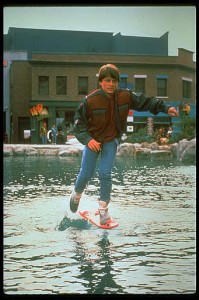Wouldn’t it be great if all it took to time travel was reaching a speed of 88 miles an hour and harnessing 1.21 gigawatts of energy?
I won’t be greedy. I’d settle for a hoverboard.
Maybe the hoverboard won’t be on my Christmas list this year, but it might not be too long before it is.
The School of Physics at Tel Aviv University recently demonstrated success in achieving “quantum levitation.” They created a superconducting magnetic system that allows an object to hover above a magnet. It doesn’t just float there–it’s actually quantum locked.
The moving object, in this case a disc, is coated with a superconducting layer of liquid nitrogen. The liquid nitrogen freezes the disk and allows it to lock the magnetic field from the magnet below. This lock is so strong that it doesn’t break when you push, tilt, or spin the disc, so the object remains in levitation. Quantum locking is so strong that it can works even when the disc travels underneath the track.
Watch the quantum levitation clip here.
Still, there are a few details to iron out before hoverboards hit the market, or before you can buy your first flying car.
First: where on earth can we find a big, strong magnet?
One of the reasons this technology is so exciting is that it could harness one of earth’s most powerful existing forces. Earth’s magnetic field brings our hoverboard dreams a little closer to reality. We just have to figure out exactly how to harness and perhaps amplify it. The shape of the object would likely come into play here–something more three-dimensional than a disc might be able to more effectively capture a magnetic field.
If we’re going to make flying cars or a public transportation system like the one in Minority Report, we’ll need to make sure the superconductors can hold enough weight. One idea is to use one of several existing techniques or figure out new means to increase the amount of energy stored by a superconductor. However, as electro-magnetic current increases, a superconductor can reach critical current, which compromises a material’s superconductivity.
The biggest hurdle is keeping the superconductor cool, especially when the object is much larger than a disk. One would think that a New England winter would suffice, but apparently not. Scientists are making some progress with ceramic, but nothing that has solved this problem (another drawback of ceramic is that it can’t withstand as much weight). On the bright side, I hear space is pretty cold.
Despite the obstacles, the footage from the Association of Science-Technology Centers dazzles with possibility. Think of what we could do if we could circumvent friction. Think of the breaking systems. Cogs and gears moving without actually touching. Think of the rollercoasters. The air hockey. One day in the near future, you might be able to hitch a ride on the back of a flying car while on a hoverboard. Just be sure you don’t end up back in the Wild West thinking, giga-whatt?

